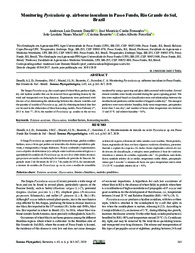Monitoring Pyricularia sp. airborne inoculum in Passo Fundo, Rio Grande do Sul, Brazil.
Monitoring Pyricularia sp. airborne inoculum in Passo Fundo, Rio Grande do Sul, Brazil.
Resumo: The fungus Pyricularia sp., the causal agent of wheat blast, produces light, dry and hyaline conidia that can be removed from sporulating lesions by the wind and transported over long distances. Experiments were performed with the aim of (a) determining the relationship between the climate variables and the quantity of conidia of Pyricularia sp.,and (b) obtaining technical data that can be used in the elaboration of blast forecasting models.From February 2nd, 2013 to June 7th, 2014, the number of Pyricularia sp. conidia in the air was monitored by using a spore trap and glass slides smeared with vaseline. Several climate variables were hourly recorded during the spore capturing period. The data were explored based on classification trees and relationships between the weather-based predictors and the number of trapped conidia day-1. The strongest predictors were mean relative humidity, daily mean temperature, precipitation lower than 5 mm day-1,and number of hours when temperature was between 15 and 35 °C and relative humidity > 93%.
Ano de publicação: 2019
Tipo de publicação: Artigo de periódico
Unidade: Embrapa Trigo
Observações
1 - Por padrão são exibidas publicações dos últimos 20 anos. Para encontrar publicações mais antigas, configure o filtro ano de publicação, colocando o ano a partir do qual você deseja encontrar publicações. O filtro está na coluna da esquerda na busca acima.
2 - Para ler algumas publicações da Embrapa (apenas as que estão em formato ePub), é necessário ter, no celular ou computador, um desses softwares gratuitos. Sistemas Android: Google Play Livros; IOS: iBooks; Windows e Linux: software Calibre.
Acesse outras publicações
Acesse a Base de Dados da Pesquisa Agropecuária (BDPA) para consultar o acervo completo das bibliotecas da Embrapa.

